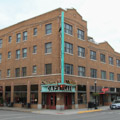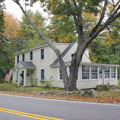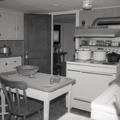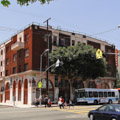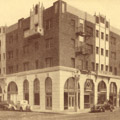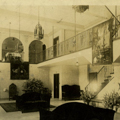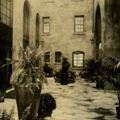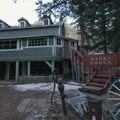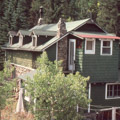Roadside architecture, which had its heyday from World War II until the late 1960s, has been celebrated for both its enterprising spirit and for its lively approach to architectural form. At the height of their popularity, roadside motels, diners, and gas stations sought to catch the weary driver’s eye as they leapt into view with visual gimmicks and unexpected profiles, such as that of the Wigwam Motel on Route 66 in Holbrook, Arizona. Restaurants, service stations, and motels that were oriented to automobile travelers proliferated in the 1950s, often located along popular travel corridors like Route 66, and later, near off ramps of the interstate highway system. Although ostensibly open to all customers, the reality for many African American travelers was often very different. Even though discrimination was not legal in many states, white proprietors turned away Black travelers through a variety of thin ruses. Vacancy signs would be turned off when a Black family pulled up to a motel, a service station restroom would be suddenly “out of order,” and the pumps empty, or the kitchen might be closed at a cafe, despite the blinking “open” sign.
The publication of travel guides aimed at Black travelers, such as the Green Book, began in the early 1930s and grew in popularity and scope through the early 1960s, providing a way to circumvent discrimination and avoid encounters with hostile whites while also directing tourists’ dollars toward Black-owned or Black-friendly businesses. The opportunity that cars provided—to travel without restriction or direct oversight by white authorities—combined with the network of accommodations that would ease the journey and even make it enjoyable, opened up a freedom of mobility that had not existed before.
While the guides are seen today as an important artifact of life during Jim Crow–era segregation, they are also important textual maps that make an otherwise obscured spatial imprint of segregation visible across the landscape. As such, they describe multiple paths along which African Americans could theoretically navigate the entire country safely and without harassment. Reading across geography, it is possible to map potential itineraries through nearly all 50 states using travel guides like the Green Book, with each entry a node along a network that connects the U.S. These itineraries make evident not just the variety of and need for Black spaces in every state, but the transportation corridors through which people traveled to reach them.
The earliest national guide for Black travelers was Hackley & Harrison’s Hotel Guide for Colored Travelers (1930) by Sadie Harrison, the secretary of the Negro Welfare Council (also known as the Negro Urban League). In 1936, Victor H. Green, a postal worker from Harlem, New York, began producing what would become an annual publication, The Negro Motorist Green Book, later retitled The Negro Traveler’s Green Book. Like travel guides for white travelers, the Green Book listed, state by state, the hotels, motels, tourist homes, restaurants, service stations, and other amenities that were reported to be open and friendly to Black travelers. Modeled on earlier guides for Jewish travelers, the Green Book was the longest running and most popular of the guides for African Americans published between World War II and the passing of the Civil Rights Act of 1964, which desegregated public accommodations and obviated the need for such guides. In addition to the Jewish guides that Green admired, there were other precedents for Black travel guides. Negro directories were published in cities and states with substantial Black populations, and primarily listed the location of churches, general stores, dentists, lawyers, and other commercial and professional businesses. The directories were both practical publications that provided information to the public and documents of a community’s record of achievement and advancement in the professions. Directories also encouraged the investment in Black businesses rather than in white-owned ones that exploited or excluded non-white shoppers and workers.
Other guides appeared after World War II in response to the increase in demand for accommodations and safe passage through them. Two of the most successful were the National Hotel Directory and Guide to Travel, a publication of the National Hotel Association, a trade organization for African American hoteliers that promoted members’ businesses, and Travelguide, a slim, well-designed publication that catered to a politically sophisticated audience (and featured more nightclubs), and carried the subtitle, “Vacation & Recreation without Humiliation.” Travelguide was established in 1947 by William H. Butler, an accomplished musician and composer whose network of traveling entertainment professionals provided many of Travelguide’s initial listings.
Because the Green Book guides had such a long life (1936–1967) and were so popular—by the end of its run it claimed a circulation of two million (assisted by a distribution partnership with Esso Fuel stations)—it is possible to use them to observe change in individual states and cities as the pressure for civil rights increased. The number of entries, as well as other publications serving a similar purpose, expanded every year from the end of the war until the early 1960s, suggesting that the number of places willing to accommodate Black travelers was growing. While the guides were never comprehensive listings of Black-friendly businesses, hotels, beauty shops, and restaurants, those listed in the travel guides, particularly in cities and towns, were often part of larger Black commercial districts. The Dunbar Hotel (Hotel Somerville) in Los Angeles, for example, was part of the broader Central Avenue district. In many cities where urban renewal in the 1960s and 1970s completely erased Black neighborhoods, travel guides can point to once-active blocks or streets that may now be obscured by new traffic alignments, aiding efforts to preserve at least the cultural memory, if not the buildings, in those once-vibrant places.
Restaurants and guesthouses that catered to Black customers existed well before the first guides were published. In the early part of the twentieth century, a handful of resorts were developed specifically for affluent Black vacationers, including the earliest known incorporation of a town at Highland Beach (est. 1893), near Annapolis, Maryland, established by Frederick Douglass and his son, Charles. The largest and most successful of these was Idlewild (est. 1915) in northern Michigan, known colloquially as “Black Eden.” Residential enclaves in Oak Bluffs, Massachusetts, and Saratoga Springs, New York, were adjacent to white resort areas, and were primarily the domain of affluent professionals—doctors, businessmen, and established social elites—and many Black-owned businesses developed in response to the needs of these travelers.
By the 1930s, a modest tourist infrastructure had developed that included lodgings, restaurants, resorts, travel agencies, and attractions that catered to African American travelers. Of particular note were the opportunities this tourist infrastructure provided for women. Women owned many of the tourist homes and guesthouses that were listed in Black travel guides and were a visible presence in both the guides and their advertisements. More research to connect sites in travel guides with histories of Black women’s entrepreneurship and economic self-sufficiency during this period will help illuminate this connection.
In the earliest guides, the primary typology was the guesthouse or tourist home, usually a residence that took in short-term lodgers. Rock Rest, in Kittery, Maine, was one such tourist home that began in the 1940s as an accommodation for staff who served wealthy white vacationers, and later became a destination in its own right. Organized groups that traveled frequently by car, such as fraternal organizations, church groups, and musicians, including those on the storied Chitlin’ Circuit, passed along addresses through word of mouth. These addresses would eventually form the early foundations of the Green Book and other travel guides after World War II.
Before World War II, Route 66 was an important corridor for Black travelers between Chicago and Los Angeles, and while lodgings and cafes were necessary comforts, service stations were vital. Threatt’s Filling Station (1915) in Luther, Oklahoma, is an early and remarkably intact example of an independently owned service station that was built to serve Black travelers heading in and out of Oklahoma City along Route 66. Like many Black-owned roadside businesses, Threatt’s gradually expanded to offer barbecue as well as campsites in order to capture the tourist clientele.
The majority of sites that are listed in the Green Book and other travel guides were in or near cities and small towns, but there were some businesses in rural places that were not typically included in travel guides. Some of these remain the best surviving buildings from this era, perhaps because they were not affected by the urban renewal policies that targeted Black neighborhoods. A particularly fine example is Wink’s Panorama (1925), in Pinecliffe, Colorado. Purpose-built by Wendall “Winks” Hamlet to be a destination for African American vacationers to the Rocky Mountains, Wink’s was part of a larger Black resort development called Lincoln Hills.
Despite their remoteness, the presence of the national parks drew many travelers, Black and white. The Green Book opens a window into the nuances of racial attitudes that could hardly be gathered through other means, particularly in the Intermountain West, where local Black populations were scarce. The Murray Hotel (est. 1904), in Livingston, Montana (a gateway to Yellowstone National Park), which appeared in the Green Book from 1956 to 1963, is an example of a white-owned hotel in a majority white town that appears to have been integrated, but it is hard to know on what terms. In 1948, several letters about racial conditions in the region were printed in the Green Book. They reveal that racial attitudes in towns where there were few Black people but a great dependence on tourist dollars could be complex and contradictory. In Nevada, the Moulin Rouge Hotel and Casino (1955) in Las Vegas (heavily promoted by William Butler in Travelguide) opened to great fanfare as the first “integrated” casino, though integration in this instance meant white patrons were welcomed into a businesses in a Black neighborhood.
The 1964 Civil Rights Act was a watershed moment for businesses dependent on the patronage of Black travelers, who could now go where they liked. Most of the guides, including the Green Book, stopped publishing around this time if not earlier, and many businesses appear to have faltered and closed following the desegregation of public accommodations. In cities, commercial districts failed, people moved into neighborhoods that had previously barred them, and disinvestment increased, opening the door for urban renewal and erasure.
It is difficult to estimate how many businesses listed in the Green Book and other travel guides have survived, and more so when you include those that did not appear those publications. A rough estimate might proffer 15 to 20 percent of the buildings still extant, but that number varies greatly from state to state and city to city. In 2015, the Schomburg Center for Research in Black Culture of the New York Public Library digitized and released the 23 volumes of the Green Book (covering the years 1937 to 1967) for public use. This project has dramatically increased research and preservation efforts for sites listed in the Green Book, and state and local efforts to document and map the existing resources continue to expand.
References
Aron, Cindy S. Working at Play: A History of Vacations in the United States. New York: Oxford University Press, 2001.
Bay, Mia, and Ann Fabian, editors. Race and Retail. Consumption Across the Color Line. New Brunswick, NJ: Rutgers University Press, 2015.
Hale, Grace Elizabeth. “Bounding Consumption.” In Making Whiteness: The Culture of Segregation in the South, 1890-1940, 121-197. New York: Vintage Books, 1998.
Reut, Jennifer. “Travelguide: Vacation and Recreation Without Humiliation.” National Trust for Historic Preservation. Accessed May 13, 2020. https://savingplaces.org/.
Rugh, Susan Sessions. “Vacation Without Humiliation.” In Are We There Yet? The Golden Age of American Family Vacations, 68-91. Lawrence: University of Kansas Press, 2008.
Schomburg Center for Research in Black Culture, Manuscripts, Archives and Rare Books Division, The New York Public Library. “The Negro Motorist Green Book.” New York Public Library Digital Collections.
Sorin, Gretchen Sullivan. “‘Keep Going’: African Americans on the Road in the Era of Jim Crow.” Ph.D. dissertation, University at Albany, State University of New York, 2009.
Williams, Clay. “The Guide for Colored Travelers: A Reflection of the Urban League.” The Journal of American and Comparative Cultures 24, no. 3‐4 (Fall/Winter 2001): 71-79.
Wolcott, Victoria W. Race, Riots, and Roller Coasters: The Struggle for Segregated Recreation in America. Philadelphia: University of Pennsylvania Press, 2012.
Writing Credits
If SAH Archipedia has been useful to you, please consider supporting it.
SAH Archipedia tells the story of the United States through its buildings, landscapes, and cities. This freely available resource empowers the public with authoritative knowledge that deepens their understanding and appreciation of the built environment. But the Society of Architectural Historians, which created SAH Archipedia with University of Virginia Press, needs your support to maintain the high-caliber research, writing, photography, cartography, editing, design, and programming that make SAH Archipedia a trusted online resource available to all who value the history of place, heritage tourism, and learning.

